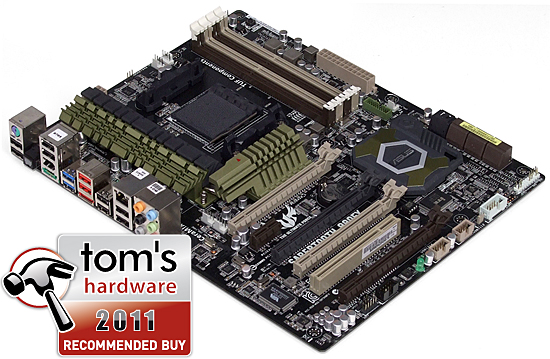Five $160 To $240 990FX-Based Socket AM3+ Motherboards
Forty-two PCIe lanes give the 990FX a clear connectivity lead over competing Intel chipsets. We compare five class-leading products using AMD's FX-8150 to see which offers the best combination of performance, overclocking, integrated features, and value.
Which 990FX Board Should You Buy?
If value were simply a comparison of performance per dollar, MSI would walk away a clear winner by providing the cheapest board in this round-up. This is a story about enthusiast-class motherboards, though, and for $10 more, an enthusiast can get a motherboard with fully-functional overclocking controls today. We realize that further development could put MSI on top in the near future, but the 990FXA-GD80 has yet to prove itself in this regard. The board could be a top value to anyone who doesn’t overclock, but the enhanced capabilities of its competitors are worth far more than the $10 price difference to us.
ASRock arguably provides the most features for the money, yet one of the features missing is three-way SLI capability. Past experience also dissuades us from using its x4 slot to enable three-way CrossFireX. Added Ethernet and USB 3.0 ports surely make the Fatal1ty 990FX Professional a top pick for anyone who desires neither overclocking nor three-way graphics configurations, but a true enthusiast product should really offer both.
Furthering the cause for added features, ECS’ A990FXM-A includes both three-way SLI and dual gigabit Ethernet controllers. ECS even adds a Bluetooth transceiver, all for a petty $50 over competing models from Asus and ASRock. While its biggest problem is an underdeveloped firmware that doesn’t properly support overclocking AMD’s new FX processors, the most nagging layout issue is its inability to accommodate many graphics card models once front-panel USB 3.0 is connected. The A990FXM-A is attractive, yet troublesome in so many ways that we’re left perplexed, and that’s not a feeling we’d want to pay an extra $50 for.
With six graphics card slots, eight internal SATA 6Gb/s ports and eSATA 6Gb/s, Gigabyte’s 990FXA-UD7 is almost in a league of its own. It even costs $10 less than the otherwise-featured ECS competitor, while offering four-way SLI. We believe four-way SLI is a killer feature, though not many builders use it.
The problem is that using four-way SLI in the 990FXA-UD7 prevents the use of its USB 3.0 front-panel header. We can’t even add a third-party USB 3.0 controller card to gain another header in this configuration, since all the slots are full. And we are beginning to think that front-panel USB 3.0 is yet another killer feature.
In the end it’s the top overclockers that get our attention. A low price and great firmware put Asus $190 Sabertooth 990FX side-by-side with Gigabyte’s $230 quad-SLI 990FXA-UD7. Our inability to overlook Gigabyte’s poor USB 3.0 front panel header placement makes it far easier for us to choose the cheaper Asus model for our own systems.
Get Tom's Hardware's best news and in-depth reviews, straight to your inbox.
-
timbo1130 How is this relevant to enthusiast? Bulldozer is out classed by Sandy Bridge I don't care if there are a few less sata ports. If you need to upgrade your better off going with Sandy bridge and z68 or p67 or wait for SB-E and X79.Reply -
julianbautista87 thanks for this article. I was waiting for it since some guy said that the 8150 was performing badly because of the mainboard used, but now I see that that was not correct.Reply -
_Pez_ Yeah If were to buy this boards would be with a Phenom real 6 core CPU 1100T :D that is the smartest choice. I think.Reply -
frostweaver I would wait till next year to decide. I still feel that windows 7 aint optimized for BD.Reply -
Tijok First off, thanks for the great article, good to see Tom's is keeping up the top notch quality!Reply
Secondly, I would really like to see a piece on extreme CFX/SLI configurations on rigs like this. It seems an article with reliable information on this would be beneficial to gaming enthusiasts, IT professionals, and HPC builders alike!
Hope to see an article along these lines soon! -
palladin9479 I bought the Sabertooth during the summer and I can attest to how amazing that board is. It's really nice, lots of features and high quality. I'm running a Phenom II X4 970BE @ 4.3Ghz on water right now. Absolutely wonderful system.Reply -
ta152h What a bunch of pretzel logic we have in this article.ReplyOf course, a fan of Intel's work could argue against the need for 42 lanes of second-gen PCIe when the 36 native to X58 Express support multi-card graphics configurations just as capably. But such a comparison really isn't necessary. After all, we've known for almost a year that Intel’s lower-cost Sandy Bridge-based part outperform the pricey six-core Gulftown-based processors in many desktop benchmarks, including pretty much every gaming scenario we throw at the two platforms.
So, x58 is irrelevant, because SB beats it. Except AMD's offering is somehow relevant even though both x58 and SB beat it. What?????
If you ignore x58 because SB offers better performance, you ignore anything AMD has because a SB setup offers better performance. If you want 36 or less lanes, x58 still offers better processors than you can hope to get from AMD. Bizarre logic.
Not that AMD is irrelevant, just the logic is badly flawed.

